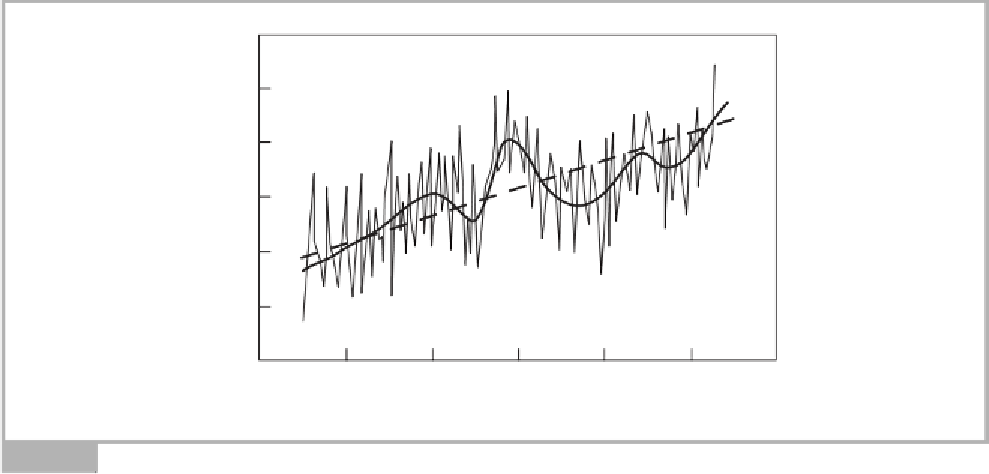Geoscience Reference
In-Depth Information
60
50
40
30
20
10
0
1992
1994
1996
1998
2000
2002
2004
Year
Global sea level change, 1992-2002 (Colorado Center for Astrodynamics Research, 2003).
Fig. 8.11
century required only a 20 per cent reduction in alpine
ice volume. Anthropogenic effects in fact dominate
global sea level changes. The two main mechanisms
are through damming and groundwater extraction.
These effects work in opposition to each other. Dams,
built mainly since 1950, presently impound between
530 km
3
and 740 km
3
of water. This is equivalent to a
decrease in sea level of 1.3-1.8 mm yr
-1
. On the other
hand, groundwater extraction is raising sea level. The
United States obtains 20 per cent of its annual water
consumption from groundwater. This amounts to
123 km
3
, equivalent to a rise in sea level of 0.3 mm yr
-1
.
If the source of the whole world's annual water
consumption of 2405 km
3
were proportional to that in
the United States, then it would equate to a sea level
rise of 1.3 mm yr
-1
. Other activities that alter the global
hydrological balance include deforestation, draining of
wetlands, lake reclamation, and irrigation. In total,
human activity could be reducing sea level by
0.9 mm yr
-1
. This means that the natural rate of sea
level rise could be as high as 2.75 mm yr
-1
. Continued
dam construction will maintain the human buffer on
this natural rise, but there is a finite limit to the
amount of water that can be impounded. By the year
2020, this limit should be reached and the rate of
measured sea level rise could double. Fortunately,
there is an economical solution for negating future sea
level rises. Seawater could be diverted, with minimal
effort, into depressions such as the Dead Sea, the
Qattara Depression in Egypt, Lake Eyre in Australia
and the Caspian Sea. These basins have very large
areas below sea level that could easily hold increased
ocean volumes.
Global sea level and the hydrological
cycl
e
(Bryant, 1993)
The cyclicity present in Figure 8.11 is problematic.
Certainly, a high frequency component of about four
months exists with amplitudes of 15-20 mm. A longer
term fluctuation of about two years' duration also
exists. The latter is probably the quasi-biennial oscilla-
tion, which has a periodicity of 2.2 years. This
oscillation is a stratospheric phenomenon that appears
in various countries' rainfall records. This implies that
the fluctuations are climatically induced, reflecting
seasonal and inter-annual variations in the global
hydrological cycle. The tide gauge records presented in
Figure 8.9 demonstrate this aspect, despite the domi-
nance of local factors. Changes in sea level recorded on
tide gauges are remarkably coherent across the globe.
For example, sea levels in southern California rise at
the same time as those in southern Australia decrease;
sea level at Sydney, Australia, tends to rise one year
before it does at London and Venice; and sea level at
London or Venice tends to rise one year before it does
at New York or Tokyo. This coincidence accounts for
about 62 per cent of the annual variation in sea level
fluctuations amongst these five cities. As Figure 8.9
illustrates, sea levels oscillate 40-150 mm every 3-5
years. This periodicity is characteristic of the Southern
Oscillation, which has the greatest effect on rainfalls,





